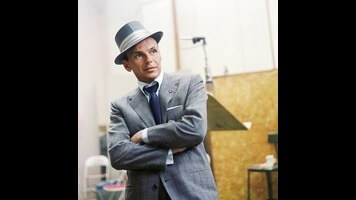There are two important and illustrative quotes in the opening half of HBO’s documentary miniseries Sinatra: All Or Nothing At All. The first is a statement of purpose, an explanation for the deep, documentary dive that director Alex Gibney (fresh off the scathing Scientology exposé Going Clear) takes into the life and work of Francis Albert Sinatra: “We don’t know what he thought about his own life, because he never wrote it down in a book.” All Or Nothing At All is here in place of that autobiography, posthumously piecing together the story of a pop-culture legend through newspaper clippings and still photography, moving pictures and interview audio.
The other quote addresses the myth of Sinatra, the outsized public persona that similarly accounts for the weight of All Or Nothing At All. Addressing the rumor that Sinatra booked his comeback role in From Here To Eternity through mob intimidation—a rumor later fictionalized in the opening sequence of The Godfather—the film bristles: “The Godfather thing is a wonderful story, but it doesn’t have to be true as documentary.” Plenty of similar stories piled up around the entertainer in the period depicted in the film—from Sinatra’s birth in Hoboken to his first “retirement” concert in Los Angeles—and Sinatra: All Or Nothing At All seemingly addresses every last one of them. Its eyes are trained on the truth, but its ears are open for a good story.
As with Gibney’s previous profiles of James Brown, Jimi Hendrix, and Fela Kuti, All Or Nothing At All must forego direct access to its primary source, who died nearly 17 years ago. Instead, Sinatra speaks for himself through archival materials, with the direction by Gibney and the editing of Sam Pollard, Ben Sozanski, and Anoosh Tertzakian representing the smoothness and sophistication that was Old Blue Eyes’ public signature. With their primary sources remaining offscreen, the behind-the-scenes team effortlessly blends new interviews with old, synthesizing source material of varying quality into a single, velvety narrative. When Sinatra makes his Las Vegas entrée in part two, stock gambling footage mingles comfortably with home movies of the Rat Pack palling around in their desert playground.
The documentary is exhaustive, but what else can be expected from a film that takes “All Or Nothing At All” as its namesake? Framing the film within the retirement concert’s set list is a canny move, but it also invites a bit of clock-watching. The minutes between song titles pile up during the scenes from Sinatra’s early life, and the doc’s attempt to capture 56 years in four hours seems to get the better of it. Part two, meanwhile, would have benefited from stronger prioritization. There’s a brave refusal to shy away from the musician’s ties to gangsters and politicans, and Mia Farrow gets to tell the story of her romance with Sinatra practically uninterrupted, but the tone takes a strange shift during a lengthy interlude about Frank Sinatra Jr.’s kidnapping. For a too-long period, the definitive documentary portrait of Frank Sinatra turns into an Investigation Discovery true-crime special, complete with dramatic reenactment. But the heft of the doc is more often than not justified by the stature of its subject and the scale of the stories surrounding him.
All Or Nothing At All is imperfect, but it makes a riveting effort at capturing its subject’s complex and complicated personality. Through Gibney’s lens, Frank Sinatra is both the world’s greatest entertainer and his own harshest critic. In interview audio, Harry Belafonte marvels at the civil-rights causes Sinatra championed, then laments the racist comedy routines that Frankie and Dean Martin later roped Sammy Davis Jr. into. It’s in these instances that the length of All Or Nothing At All is on Gibney’s side, its four hours allowing Sinatra’s opinions, sensibilities, and relationships to evolve in something like real time. It also allows for some clever work with that retirement-concert set list, introducing “I’ll Never Smile Again” as a wartime requiem in part one, then bringing it back under footage of a nation mourning one of Sinatra’s most powerful friends, John F. Kennedy. The times reflect the man as often as the man reflects the times.















![Rob Reiner's son booked for murder amid homicide investigation [Updated]](https://img.pastemagazine.com/wp-content/avuploads/2025/12/15131025/MixCollage-15-Dec-2025-01-10-PM-9121.jpg)

























![HBO teases new Euphoria, Larry David, and much more in 2026 sizzle reel [Updated]](https://img.pastemagazine.com/wp-content/avuploads/2025/12/12100344/MixCollage-12-Dec-2025-09-56-AM-9137.jpg)